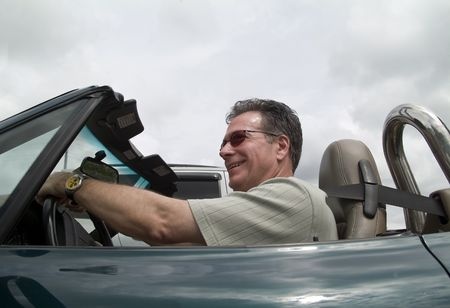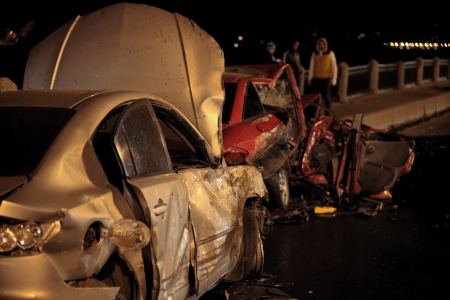

How Safe Are Convertibles?


What is the Danger of a Rollover Accident in a Convertible?
The truth is that the real danger is being involved in a rollover car accident at all. Statistically, 20 percent of car crashes with a fatal outcome involve a vehicle being overturned while only five percent of car accidents involve a rollover. This translates to a very high rate of car accident deaths from a small percentage of vehicle rollovers. The main reason that a rollover is so dangerous is the risk that passengers will fly out of their seats; clearly this could happen easily if the person is not wearing a seatbelt. Many cars are now built with padded roofs to help protect the head should they be released from their seat in a rollover accident but this doesn’t help passengers in a convertible. A person ejected from their seat in a convertible vehicle is likely to receive very serious or life threatening injuries.
In some convertibles, the passengers are the second tallest objects in the vehicle which means that if the taller objects like the windscreen and A-pillars are damaged in a crash, the passengers’ heads are vulnerable to damage. Car manufacturers such as BMW, Citoren and Saab have been working to make improvements to convertible safety both by reducing the likelihood that a passenger will be ejected from their seat (by building seatbelts right into the seat) and by improving protection for those who do leave their seat.
BMW installs a hidden rollover safety system in its 325Ci that includes high-strength bars that spring up in less than 110 milliseconds if the vehicle overturns. It also has a strengthened windscreen surround that is less likely to buckle under pressure in an accident.
Citroen has made its own safety improvements to the C3 Pluriel. The structure is very well reinforced, with roof arches, windscreen pillars and rear seats all being given extra strength so that the car is less likely to crumple if a rollover occurs. The head restraints also have integral rollover bars that work together with reinforced seats to provide a virtually crush-resistant area.
Saab uses a pop-up protection system in its 9-3 convertible, similar to the one used in the BMW. The safety system is called the DynaCage and when a heavy impact is sustained or the sensors on the car detect that it may roll over, bars built into the seats pop up behind the head restraints. It also has a reinforced windscreen frame, sills and A-pillars for a strong body structure.
The reality is that the odds of being in a rollover car accident are very low and even if you are riding in a convertible, there have been many safety improvements made to help keep you safe. The best thing you can do to avoid a serious car accident injury is to pick a model with adequate safety features, drive defensively, and always wear your seatbelt!
If you or a loved one were involved in a car accident, please don’t fight your insurance company alone. Do not underestimate the ability of an accident attorney to get the job done: the Insurance Research Council found that insurance payouts to clients are 3.5 times higher to those who hired an accident attorney. Call the experienced accident lawyers at Tario & Associates, P.S. to setup your FREE CONSULTATION today!
Read More

A Report on Washington State Car Accidents
Despite an increase in motorists, Washington State has seen a significant decline in car accident related deaths in the last decade. Most American adults drive; according to the U.S. Census Bureau, there are close to 211 million licensed drivers on our roads and highways. While we are taught to keep our hands on the wheel and our eyes on the road and the speedometer, the reality is that there are many drivers who drive impaired, distracted, or that drive recklessly fast. Car accidents and corresponding fatalities and injuries are a reality we accept in order for the privilege to drive.
Accident Statistics vary from state to state.
What are Washington State’s car accident statistics?
Washington State Fatal Car Accident Statistics
- Washington State’s traffic fatality rate declined each year between 2006 and 2010. The rate in 2006 was 1.12 deaths per one million automobile miles traveled and it dropped to .8 deaths per million miles travelled in 2010.
- There were 460 deaths associated with car accidents in 2010.
- People between the ages of 21 and 25 experienced the most traffic related deaths of any group.
- More than 64 percent of all car accident fatalities between 2006 and 2010 were to the driver.
- More than 46 percent of car accident deaths occurred on state roadways, 20 percent occurred on city streets, and 31 percent took place on county roads.
- July and August are the deadliest months for drivers.
- The majority of fatal car accidents were involved in a low-speed collision, meaning driving less than 35 miles per hour.
- The overall level of traffic fatalities in Washington was comparable to the national average.
Serious Injury from Car Accidents in Washington State
- The number of serious injuries from car accidents declined from almost 3,000 in 2006 to 2,474 in 2010 (a 17 percent decrease).
- The driver was almost three times more likely to be seriously injured in a car accident than a passenger.
- July and August had the most serious injuries from car accidents.
- Forty-four percent of serious injuries from a car accident occurred in a passenger vehicle while 38 percent occurred in a pickup truck, SUV or van.
Washington State Drunk Driving Statistics
- Between 2006 and 2010, there were a total of 1,323 deaths associated with drunken driving.
- The rate of impaired driving deaths has declined every since 2006; in 2006 there were 301 fatalities and in 2010 there were 230.
- Impaired driving related deaths were the highest among the 21-25 year age group and in the summer months.
- DUI related deaths nearly doubled on the weekends when compared to weekday driving.
Distracted Driving Statistics for Washington State
- On average, distracted driving accidents caused 152 deaths each year between 2004-2008.
- Between 2004-2008, distracted driving was a contributing factor in more than 25 percent of all fatal car accidents.
- Drivers aged 16-25 were involved in 26 percent of all distracted driving related deaths compared to 14 percent for people over the age of 70.
- Fifty percent of all distraction related fatalities occurred on the weekends.
If you or a loved one has suffered a serious injury or death due to a car accident, talk to an experienced car accident attorney who can fight for compensation on your behalf. Do not underestimate the ability of an accident attorney to get the job done: the Insurance Research Council found that insurance payouts to clients are 3.5 times higher to those who hired an accident attorney. Call the experienced car accident lawyers at Tario & Associates, P.S. today!
Read More

U.S. Car Accident Deaths on the Decline!
After a disturbing uptick in car accident deaths in 2012, U.S. traffic deaths fell by 4.2 percent during the first half of 2013, according to early figures from the National Highway Traffic Safety Administration (NHTSA). Accident related highway deaths had been on a sharp decline for most of the last decade before reversing course in 2012 with a 4.4 percent increase. Despite the decline in 2013, the federal safety agency still estimated that 15,470 people died in all forms of motor vehicle crashes between January 1 and June 30. This number accounts for all car accident deaths nationally including motorcycle deaths for the first half of the year. Additionally, some states have seen their car accident death rates decrease while others have seen increases.
This welcome ebb in car accident related deaths actually comes as a surprise to government officials who had predicted an increase in fatalities as the economy improves and there are more cars on the road during rush hour. Officials are studying the reasons for this outcome and possible factors include:
- Crackdowns on impaired and distracted driving.
- Increased awareness of the effects and consequences of impaired and distracted driving.
- Improved car safety systems such as better vehicle and airbag designs.
- New technologies such as the electronic stability control now required in all new vehicles and further improvements to collision avoidance systems.
Studies will likely show even more reasons for the rate of accident death decline but whatever they are, it is good news. If this trajectory holds, road deaths will have taken a 26 percent nose dive since 2005 and an even more staggering 40 percent decline since their peak in 1972 with 54,589 deaths. It wasn’t so long ago on the late 1970s that more than 50,000 Americans were dying in car accidents every year and it took until 2008 before the number dropped below 40,000.
Despite the overall good news, there are some serious concerns over the rise in motorcycle deaths in 2012 (The NHTSA has not yet provided numbers for 2013). Sadly, despite the direct correlation between decreased helmet use and increased deaths more states are taking a “freedom” approach and reversing motorcycle helmet laws. For example in Michigan, motorcycle deaths rose an alarming 18 percent in 2012 after ending their helmet law in April. The overall trend doesn’t look good either as motorcyclist fatalities have more than doubled since the mid 1990s to almost 4,550 last year. According to a report by fairwarning.org biker groups backed by major motorcycle manufacturers are advocating for or against the following laws in Washington:
- Repeal State helmet laws.
- Implementing a rule that would prevent the NHTSA from providing any more grants to states to conduct highway stops of motorcyclists to check for safety violations such as wearing helmets that don’t meet federal standards.
- Preserve a rule to prevent the NHTSA from communicating safety measures at the state and local levels, in place since 1998.
- Derail a measure to reinstate financial penalties for states lacking helmet laws.
This lobbying on Capitol Hill has caused downward pressure on state legislators who have begun repealing helmet laws in alarming numbers. Compared to the late 1970s where 47 states had helmet laws, only 19 states do today. Although Washington State does not have a bicycle helmet law it does require helmets for Motorcycle riders.
Helmets save lives! The NHTSA estimates that helmets saved 1,483 lives in 2009 and that 732 deaths could have been prevented if all riders had worn a helmet.
Automakers and automotive safety equipment manufacturers would like nothing more than to eliminate all vehicle deaths in their vehicles and equipment but it is unclear how this would ever be accomplished. In the mean time, safety advances are real and getting better every year.
If you or a loved one were injured or killed in a car accident the last thing you need is to be negotiating with your insurance company for a settlement. An experienced car accident attorney will identify the particulars of your accident and get the best settlement possible for your case. Call the car accident lawyers at Tario & Associates, P.S. today!
Read More